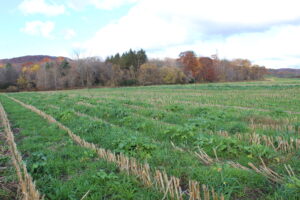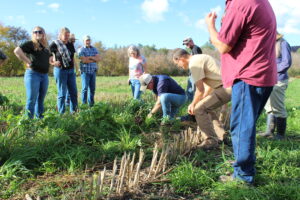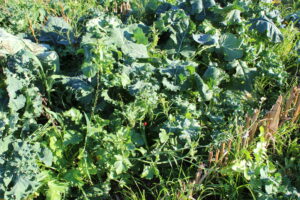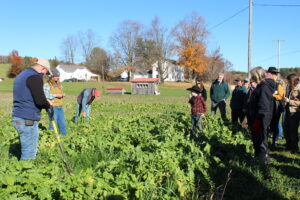Final report for ONE19-330
Project Information
Establishment of cover crops following fall harvest of silage corn in the northeast can be difficult. Many farms broadcast grain rye successfully, but many acres are left without a living plant cover over the winter, resulting in reduced soil health, run-off and erosion. In this grant our goal was to increase understanding of soil health principles and to demonstrate the use of an interseeded diverse cover crop mix early in the season. Interseeding at the the V1-V2 leaf stage can allow a cover crop to be established that can grow rapidly once the corn crop is harvested to provide living roots in the soil over the winter months. Three farms interseeded a diverse cover crop mix on demonstration plots over a three year period. Soil samples were taken each year to discern changes in soil health parameters. Farmer demonstrators received one-on-one expert consultation on interpreting soil testing results and review of their management practices.
Planning for success in interseeding should include consideration of equipment, timing, plant maturation dates, plant growth habit, and choice of cover crop mix. Those farms with a commitment to cover crop use view interseeding as a next step in soil health practice by introducing plant diversity and found that having an established fall cover crop facilitates fall manure applications. Through two public field talks and a day-long soil health workshop, the grant reached approximately 45 farmers, ag service providers and educators. The farmer demonstrators are leaders in the local community and influence other farmers by demonstrating innovative practices.
This project seeks to demonstrate that farmers can markedly improve soil health in silage cornfields using interseeded, multi-species cover crop mixes alone and with the addition of adaptive grazing. Farmers will learn to monitor soil health indicators for changes in functionality over time, using a water infiltration test and slake test for aggregate stability.
Our goal is to provide technical support to innovative farmer-leaders who will demonstrate successful regenerative practices on their farms and inspire increased adoption of a full suite of soil health practices in our farming community using on-farm, farmer-to-farmer demonstrations.
Participating in the project will result in increased use of multi-species, interseeded cover crops in corn plantings. Soil health improvements will be measured through annual soil tests and on-farm monitoring. Information will be shared with other farmers and agricultural educators and service providers through field days. Demonstrated successful practices will be adopted by other farmers in the area.
Farmers using these soil health practices reduce their inputs of fertilizers and pesticides while increasing their farm’s resilience to the extremes of precipitation.
Recent research has greatly improved our understanding of soil health. It highlights the central role of soil microbial life in improving soil health and reveals the importance of creating a hospitable environment for microbial communities in order to regenerate soil health. The adoption of soil health principles - minimizing soil disturbance, crop diversity, use of cover crops and integrating livestock - offers many benefits to farmers. By applying these principles, farmers can build soil organic matter and create stable soil aggregates that resist erosion and nutrient loss while improving water holding capacity and nutrient availability. Improved soil health provides benefits not only to farmers but also to society at large. Soil health improves water quality, reduces soil erosion, fosters a reduction in herbicide, pesticide and fertilizer applications, and removes atmospheric carbon and returns it to the soil via photosynthesizing green plants in symbiotic relationship with soil microbial life. Adaptive grazing has been shown to support the soil microbial community and accelerate the formation of soil organic matter.
Practices that improve soil health are only slowly being adopted. Estimates suggest that farmers plant cover crops on 1-5% of U.S. cropland acres, practice crop rotation on 25% of acres, and employ conservation tillage on just 25% of cropland. The recently published New York Soil Health Roadmap identified several barriers to adoption including management complexity, lack of technical assistance and policy disincentives.
Farmers also face logistical constraints including the difficulty in establishing late season cover crops after harvest and the lack of access to appropriate machinery for interseeding cover crops into a standing row crop. These are barriers to cover cropping in corn silage, nearly 1 million acres of which is grown in New York.
The New York Roadmap fails to acknowledge two of the regenerative practices demonstrated on numerous Midwestern farms through the Pasture Project and by the other farm innovators: the integration of livestock into crop production through adaptive grazing of cover crops, both during the growing season and in fall/winter, and the use of complex cover crop mixtures to accelerate improvements of soil health. Adaptive high stock density grazing is a form of grazing management that rapidly builds soil health and productivity by employing high stocking densities, frequent moves and long rest periods for paddocks. Grazing cover crops also produces direct economic benefits by providing additional livestock feed. These two benefits can make cover crops more financially viable, thus overcoming an important barrier to their adoption.
A NESARE-funded project in New York conducted cover crop trials on two dairy farms and two vegetable farms and held three field days. The project demonstrated use of various cover crops species established with several methods, including interseeding into a corn crop. The project provided valuable information on cover crop selection, methods and timing of seeding but did not focus on the effects on soil health.
Our project will provide needed expert on-farm technical support for each of the farmer-demonstrators, financial support for covering the cost of cover crop seed, and training to allow the farmers to measure changes in soil health over the life of the project. The project will also provide opportunities for farm neighbors and others to attend field days and learn from the farmers what has worked for them. The goal is to expand the farm's use of cover crops into their silage corn acreage resulting in improved soil health and reduced input costs. Improved soil health can also mitigate damage from extreme weather events, reducing soil erosion, nutrient run-off and crop loss.
Cooperators
- (Researcher)
- (Researcher)
- (Researcher)
- (Researcher)
- (Educator)
- (Educator)
- (Educator)
Research
Consultant Allen Williams spent time at three farms in October, 2019. At each farm, he talked at length with the farmers about their management practices and goals for participating in this grant project. An area for the demonstration plot was identified on each farm taking into account the ability to manage grazing as part of the treatments. Each plot was divided into three treatments: silage corn, silage corn interseeded with a multi-species cover crop at the V4-V5, and silage corn interseeded with a multi-species cover crop at the V4-V5 stage and adaptively grazed after corn harvest. Soil sampling at each location was delayed until spring, 2020 due to early onset of cold soil temperatures. Soil samples were taken in each plot for analysis using the Haney and PLFA tests, as well as soil penetrometer and water infiltration measurements.
The farmers met in January, 2020 to discuss the demonstration plots and cover crop choices in consultation with Allen Williams. They also discussed working with consultant David Brandt to retrofit a corn seeder to allow for interseeding of cover crops in standing corn. Planting took place in Spring 2020. The Project PI maintained regular contact and visits with the farmer-demonstrators to monitor progress and document growth over the season.
Soil samples were collected from the three plots on the three demonstration farms in May 2020. Water infiltration and soil compaction measurements were also collected. Soil samples were sent to Regen Ag Lab in Nebraska for Haney and PLFA analysis as per request from project consultant Dr. Allen Williams. Dr. Williams had phone conversations with farmers regarding soil analysis results and made recommendations on cover crop mix.
The demonstrator farmers were not able to retrofit equipment to use as an interseeder. The interseeder equipment expected to be delivered to the Washington County Soil and Water Conservation District for rental use by farmers was not delivered. We borrowed an Interseed Technologies seeder from Fulton County Soil and Water Conservation District but it did not arrive until July.
Silage corn was planted as usual on demonstration plots. A cover crop mix based on Dr. Williams' recommendations was purchased through a local Kings Agri seed dealer and included annual rye, buckwheat, crimson clover, flax, turnip, cow pea, and hairy vetch. The cover crop was sown in demonstration plots at Tiashoke farm at a rate of 25# per acre on July 11th using a Interseed Technologies seeder. Corn was approximately 2.5' tall. Due to the late arrival of the interseeder equipment, no cover crop was sown on the Hickory Hill and Otter Creek farm plots until after corn harvest when rye was sown using a no-till seeder.
Due to COVID travel restrictions, Dr. Williams was not able to travel to visit the farms in the fall. His colleague Morgan Hartman attended a field visit with the participating farmers, the grant PI, Soil and Water Conservation District staff, and a Cornell Cooperative Extension educator to view the results of the use of the interseeder at Tiashoke Farm, and results of broadcast cover crop in grain corn on Hickory Hill Farm.
In 2021 we still did not have access to an interseeder for our farmer demonstrators to use. There was enough cover crop seed left over from the 2020 season for the farmers to use. A germination test was done and it was determined that germination rates were acceptable for use in 2021. Soil samples were taken in May and sent to Ward Laboratories in Nebraska for Haney test. Project consultant Dr. Allen Williams reviewed the soil sample results with each farmer. Silage corn was planted as normal on the three farms. Plans were made to use a spin seeder to broadcast the cover crop seed at the V4-V5 leaf stage. The control plot on Hickory Hill was mistakenly sown with the cover crop. The multi-species seed mix from 2020 was broadcast via a spin seeder on the Otter Creek farm. The control plot was not over-sown. the Tiashoke Farm demonstration plot was not sown with the cover crop this season. Winter rye was sown on the plots post-harvest.
Dr. Williams visited the area in October 2021 and spent one-on-one time with each farmer to review soil test results and discuss their individual management practices. A public field talk was held at Otter Creek Farm where farmers, ag service providers and educators could view the results of the first two years of cover crop compared to the control plot.
In 2022 soil samples were collected from each of the three demonstration farms in mid-May and sent to Regen Lab for Haney and PFLA soil tests. Corn was planted on all three farms using a no-till seeder in late May. The same cover crop mix was ordered for use. Tiashoke Farm partnered with the nearby Landview Farm to purchase an interseeder over the winter. The tool is a rotary hoe modified with an air blown seeder. The interseeder was used on the Tiashoke Farm and Otter Creek Farm research plots and on an additional 300 acres of silage corn on Tiashoke Farm and 200 acres of silage corn on Landview Farm. Hickory Hill decided to broadcast seed on their plots. Corn was harvested mid-September to early October. Soil samples were collected from each farm again in September for Haney and PFLA testing.
In October 2022, consultant Allen Williams returned to the area to meet with the farmers. He spent a day at Tiashoke Farm and one at Otter Creek Farm consulting with the farmers on soil health, crop rotations, and grazing questions. Hickory Hill dairy was not able to make time to meet with Dr. Williams. A public field talk led by Dr. Williams was held on October 26 at Tiashoke Farm. We looked at the interseeder used and talked about the farmer's experience using it and viewed an area that had been interseeded. Corn had been harvested and the cover crop was starting to grow. We also visited a plot on the Landview Farm which had used the interseeder with positive results. The meeting was attended by farmers and ag service providers.
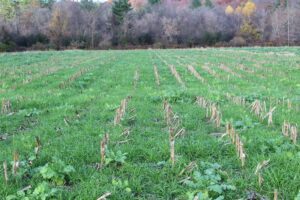
On October 27 a day long soil health workshop led by Dr. Williams was held on the Otter Creek Farm. The workshop was held as an add-on activity related to the grant. Dr. Williams gave an overview of soil biology and how our management practices affect different aspects of the soil biology and structure. Participants viewed the grant research plots and were able to see the differences in soil structure between the control and cover crop plot. In the afternoon we walked the farm to see areas that had recently been converted from row crops to permanent pasture.
Plans to modify a corn seeder in the winter of 2019/2020 were not initiated by the farmer demonstrators. The Washington County SWCD had applied for a grant to purchase an interseeder but was delayed in receiving the grant. The PI spent time over the winter and early spring months of 2020 trying to locate equipment that could be used for interseeding the cover crop into V4/V5 corn. We were able to borrow an Interseeder Technologies interseeder from the Fulton County NY Soil and Water Conservation District, but were not able to use it until after Fulton County farmers were done seeding. By the time we got the seeder in July, only Tiashoke Farm was able to use it to interseed the cover crop. The other two demonstration farms determined that the corn was too tall and too much damage would ensue from use of the interseeder.
The PI observed use of the interseeder at Tiashoke Farm and visited later in the summer to observe growth of cover crop. Hickory Hill Farm and Otter Creek farm were encouraged to try to sow the cover crop mix if the silage corn was harvested early enough. They determined that it was too late to establish many of the components of the mix, and both farms use a no-till seeder to sow grain rye in the fall.
Due to covid travel restrictions, Dr. Williams was not able to travel to New York State to meet with farmers in fall 2020. Morgan Hartman, who is an associate of Dr. Williams and lives in western Massachusetts, was available to meet with farmers. Mr. Hartman consulted with Otter Creek Farm and attended a field day in early November 2020 to view the demonstration site at Tiashoke Farm and a visit to Hickory Hill Farm. Service providers from Washington County Soil and Water Conservation District and Cornell Cooperative Extension also attended the field day. The public was not invited due to COVID restrictions. The stand of interseeded corn on the Tiashoke Farm was well established. Farmer Brian Ziehm commented on how much the cover crop grew once the corn was removed. At Hickory Hill Farm we viewed the demonstration plot area which was sown with annual rye. We also viewed cropland where a cover crop had been sown into grain corn at the V4 stage using a spin seeder. Timely rain fall had resulted in an excellent stand of cover crop in the grain corn. We discussed the option of using the spin seeder to establish cover crops in the demonstration plots if we are unable to secure the use of an interseeder for the 2021 growing season.
The benefits of the intersown cover crop were discussed in terms of late season and winter forage, as well as providing cover to reduce erosion and nutrient loss, and to benefit soil organic matter and biological activity.
During the winter of 2020/2021 we tried again to locate an interseeder or other appropriate equipment to use for interseeding at the V4/V5 stage in silage corn for the 2021 season. The PI consulted with Dr. Allen Williams on timing of 2021 soil sampling considering that there was not an early cover crop established on two of the demonstration farms in the 2020 growing season. Planning for a fall consultation visit by Dr. Williams including a public field day was made.
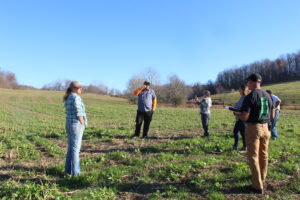
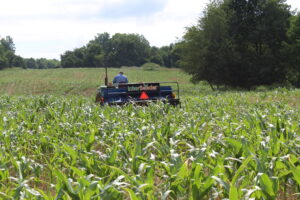
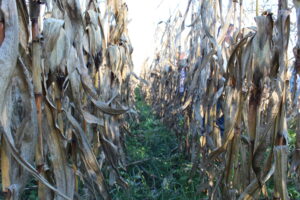
The PI was not able to locate an interseeder for use during 2021. Conditions were very dry in the spring and early summer of 2021 contributing to less than ideal conditions for establishing a cover crop via broadcasting. On both the Hickory Hill Dairy and on Otter Creek Farm plots, germination of the cover crop was somewhat spotty but ample rains during the summer supported the growth of the plants that did get established. Growth of the cover crop post-harvest was good. On the Otter Creek Farm, the area designated as cover crop + grazing was being saved for winter grazing to maximize the growth of the cover. Dr. Allen Williams visited the area on October 27 and 28 and consulted with each farm regarding soil tests, questions on herbicide use and carry over, and longer term goals for each farm. A public field talk was held on October 28th at Otter Creek Farm where Dr.Williams talked about the role of cover crops, especially multi-species covers and interseeding, in building soil health. We looked at soil structure in the control and cover crop plot and could witness the benefits of living roots in the soil structure. We had planned to take additional soil samples in the fall but did not do so because of low soil temperatures.
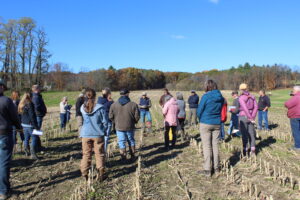 Participants of October 28, 2021 field talk at Otter Creek Farm
Participants of October 28, 2021 field talk at Otter Creek Farm
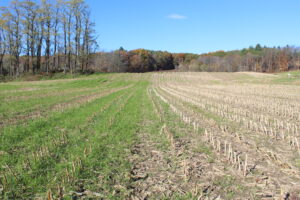
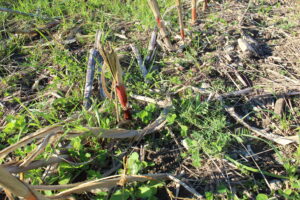
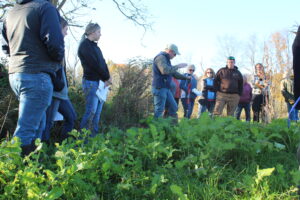
For the 2022 growing season Haney and PFLA soil tests were conducted for each farm from samples collected in May. Dr. Williams was available to consult with each farm about the soil test results. Interseeder equipment had been purchased by Tiashoke Farm in partnership with another large dairy in the area, Landview Farm, over the winter of 2021/22. Silage corn was sown in mid to late May at each farm. A multi species cover crop was sown into the demonstration plots on Tiashoke Farm and Otter Creek Farm aiming for V4-V5 leaf stage. Hickory Hill Farm used a spin seeder to sow a mix of crimson clover and annual rye. Corn was harvested for silage from mid-September to early October.
Dr. Williams led a public field talk on October 26 attended by Ag service providers, educators and farmers. The farmers who had used the interseeder felt that seeding at the V4-V5 stage was not ideal and that seeding at V1-V2 would reduce any potential damage to the corn seedlings and allow a slightly longer time frame for the cover crop to get established prior to the canopy closing. It would also allow more flexibility in timing of interseeding when the goal is to interseed several hundred acres of corn. Dr. Williams confirmed that he has found the same to be true in other locations. The farmers also discussed using corn varieties with shorter maturation dates and a more upright leaf habit as ways of supporting the growth of the cover crop. Landview Farm which cooperates with Tiashoke Farm, experimented with interseeding 60" corn rows with great success.
Our project was hampered by the onset of COVID which initially limited our ability to have public gatherings, and hindered the expected delivery of interseeder equipment to our local Soil and Water Conservation District office that we thought would be available for use. The farmers were not able to identify a piece of equipment that could be modified for interseeding with the help of consultant David Brandt which had been the alternative. As a result the farmers used a mix of approaches to establish a cover crop in early season corn silage. We found that the Interseed Technologies interseeder was difficult to transport over a distance but when used on Tiashoke Farm in the first season (2020) was very effective. From the experience of using a different type of interseeder in 2022, farmers determined that interseeding at the V1-V2 stage is preferred over the V4-V5 stage to limit damage to corn seedlings and improve cover crop establishment prior to the canopy closing. Farmer Andy Brizzel did not use the interseeder on his farm. He used a broadcast spinner which he feels give the same or better results and is more efficient than a specialized piece of equipment, and avoids the cost of another piece of equipment.
Otter Creek Farm grazed beef cattle on the cover crop + grazing plot after the 2021 growing season and for a shorter period after the 2022 season. They noted that the cattle particularly favored the turnips. Tiashoke Farm also rotated heifers through the cover + grazing plot. On Hickory Hill farm, the farmer did not have the capacity to take on the grant activities each year and did not fully participate as planned. He was not able to arrange for grazing of the cover + grazing plot. He did benefit from early consulting with Dr. Williams and continued to broadcast cover crops on both grant research plots and 80% of his corn acreage.
Dry conditions in 2020 and 2022 affected cover establishment as did timing of interseeding especially with the use of borrowed or shared equipment.
Farmers learned techniques for measuring changes in soil health including use of water infiltration rings, soil penetrometers and slake tests. They also reviewed soil samples over three years looking at the results of Haney and PFLA tests. They all report an increased understanding of soil health, the components of soil biology and how tillage, and plant diversity affects the soil biology. All of the farmers reported noting a marked difference between the control and cover crop plots, seeing a difference in worm activity and soil structure and feeling the difference "from the tractor seat" while seeding. The plots with cover crops were less compacted and used less power with the no-till seeder.
In spite of the difficulties of each farm following the protocol and establishing cover crops on the demonstration plots in each of the three years, Dr. Williams analysis of the results of soil testing over the grant period revealed that where the practices were intentionally applied, more so on Tiashoke and Otter Creek farms, we saw some differences in certain elements of the Haney and PLFA test results.
For both Otter Creek Farm and Tiashoke Farm the Haney soil test showed a decrease in Soluble Organic Matter (SOM) in the control plots compared to the plots planted with cover crops. The Organic Carbon (OC) also increased with the greatest gain shown in the CC+G. The PLFA test showed a significant difference in Total Living Microbial Biomass (TLMB) and magnitude differences in Total Fungi, Mycorrhizal fungi, and Protozaol populations between the control and cover crop treatment, with the biggest differences evident in the CC+G plot. No appreciable differences were noted for the Hickory Hill samples.
The shovel test between the Control, CC, and CC+G plots on the two farms revealed differences in soil aggregate, degree of soil compaction and plating, and soil carbon layer. On both farms, the soil aggregation was progressively better in the CC and CC+G plots compared to the Control. Soil compaction and plating was significantly and progressively less in the CC and CC+G plots. A deeper soil carbon layer was evident between the control plots and the CC and CC+G plots, with the deepest carbon deposits in the CC+G plots.
Otter Creek Farm was well into a transition away from row crop production to a grass based beef operation at the start of the grant. They dedicated a field to the grant demonstration plots and hosted a field talk and day-long workshop on their farm. They benefited greatly from the opportunity to have one-on-one consulting with Dr. Williams. Although their farm will not be growing row crops in the next several years, they feel that they now have the understanding and tools to produce row crops without damaging their soil health. Hickory Hill farm will continue to use broadcast seeding to sow cover crops into their grain corn and some of their silage corn acreage. The primary concern for farmer Andy Brizzel is to avoid run-off since his farm is in the Otter Creek watershed which supplies the water reservoir for the city of Troy NY. He has observed that having a cover crop on his fields at least once every three years prevents run-off. Brian Ziehm at Tiashoke Farm has been working to increase their use of cover crops for the past 8 years, primarily using grain rye post harvest. He sees the use of interseeding as another step in successfully establishing cover crops in corn acreage and introducing plant diversity into the cropping system. He has been successful at rolling rye cover crops in the spring prior to no-till seeding and estimates that he has reduced his herbicide use by half. He also sees benefits for managing manure applications in the fall. If the manure can be spread on an established cover crop, it is absorbed more rapidly, reducing nitrogen loss and smells which improves relations with rental landowners and neighbors.
Our goal was to increase understanding of soil health practices, to demonstrate the use of interseeder equipment to establish cover crops earlier in the season, and to support peer-to-peer learning between farmers in our area.
The grant allowed us to bring Dr. Allen Williams to the area to work one-on-one with the farmer demonstrators. Dr. Williams demonstrated soil health testing techniques, water infiltration test, use of soil penetrometer and slake tests, that the farmers can use to evaluate changes in soil health over time. Soil testing was done over the life of the grant and Dr. Williams consulted with each farm to look at the results and understand any changes as the result of cover crop use and grazing. The farmers learned the value of the Haney and PLFA tests in identifying soil microbe populations and their role in nutrient availability. All the farmer demonstrators reported increased understanding of soil health principles and the beneficial effects of diverse cover crops.
We invited other farmers, ag service personnel and educators to two field talks led by Dr. Allen Williams to look at the interseeded cover crop plots. In follow-up interviews participants reported an increased understanding of how management practices and in particular the use of cover crops affects soil health. The field talks increased interest in soil testing for biological activity and nutrient availability by farmers. Ag service providers indicated that they will use what they learned in their outreach programs with farmers.
We had mixed results in our efforts to demonstrate use of specialized equipment for interseeding cover crops in silage corn. We learned that the timing of interseeding the cover crop is critical and not easy to achieve when depending on the use of borrowed equipment. While renting an interseeder from a local soil and water district office may be a good option for smaller scale vegetable or grain operations, the larger dairy operations who hope to interseed hundreds of acres need access to their own specialized equipment. Good planning will also be necessary to achieve the best results including considerations of maturation dates, plant growth habit, row spacing, choice of cover crop mix and timing. At the end of the 2022 season, Tiashoke Farm had interseeded 300 acres of corn and their cooperating partner farm, Landview Farm, had interseeded 200 acres. They observed that seeding at V4-V5 is too late to start, and will start seeding at V1-V2 in the future. Hickory Hill Farm determined that purchasing specialized equipment is not necessary for their operation and that their practice of broadcasting a two-way mix of crimson clover and annual rye grass works well for them. Otter Creek Farm is no longer producing row crops, but from their experience feel that should their operation change in the future, interseeding of an early season diverse cover crop offers a way to produce annual crops while supporting soil health.
Tiashoke Farm and Land View Farm have both been keenly interested in soil health and increased cover crop use for the past eight years. They were already establishing rye cover crops on 80% of their corn acres at the start of the grant and had successfully experimented with rolling the rye cover before spring no-till seeding. Both farms see interseeding early in the season as a next step to expand their cover crop use, introduce diversity into their operations and offer benefits that the late rye cover crop doesn't supply. In particular, having an established cover crop in place in the fall makes manure applications much easier. They report that the cover helps absorb the nutrients from the manure faster, reducing nitrogen loss and reducing smells which improves neighbor relations. Their increased understanding of the role of mycorrhizal fungi in soil health caused them to decide not to inject manure into any field that has an established cover crop. They have been modifying manure spreading equipment with a dribble bar which lays a narrow band of manure every 30".
Some neighboring large dairy farmers who attended the field talk were not convinced that the early interseeded crop made sense for them. They would like to see a cost/benefit analysis of the practice and intend to maintain their current practice of broadcasting grain rye after silage harvest.
The main outcomes for the grant are increased understanding of soil health by each of the farmer demonstrators and the participants of the three public events held, increased understanding of Haney and PLFA soil tests, successful demonstration of the establishment of an interseeded diverse cover crop mix in silage corn, inspiring the purchase of specialized equipment for interseeding by two of the larger dairy farms in our area which will be used to seed hundreds of acres of silage corn and will be viewed by neighboring farmers. The grant also strengthened the Agricultural Stewardship Association's connections with our local Soil and Water Conservation Districts and Cornell Cooperative Extension educators to partner on future outreach programs for farmers.
Education & Outreach Activities and Participation Summary
Participation Summary:
Two articles were included in ASA's spring/summer newsletter which talk about the grant activities. The articles are available on the ASA website as well.
Cover crops benefit soil health on any scale - Agricultural Stewardship Association - Greenwich, NY June 2020
Supporting Farms Through Improved Soil Health - Agricultural Stewardship Association - Greenwich, NY
On November 9, 2020 a field visit was made to Tiashoke Farm to view the demonstration plot where the cover crop had been interseeded on July 11. The demonstrator farmers, and service providers from Washington County Soil and Water Conservation District and Cornell Cooperative Extension attended as well as the project PI and project consultant Morgan Hartman who was filling in for Dr. Allen Williams who was not able to travel due to Covid restrictions. We also visited Hickory Hill Farm and saw successful interseeded cover crop in grain corn which had been applied with a spin seeder at the V5 stage.
On October 28, 2021, a public field talk led by Dr. Allen Williams was held at the Otter Creek Farm. 10 farmers, 7 ag service providers, and 5 community members attended. Participants looked at soil test results from the demonstration plot and Dr. Williams reviewed how to interpret results from the Haney and PLFA reports. He also discussed how maintaining a live cover crop improves overall soil health and over time can reduce or eliminate the need for herbicides on cropland.
An article describing the grant activities and the October 2021 field talk by Dr. Williams was included in the fall 2021 ASA newsletter
Reducing Soil Loss, Building Resilience - Agricultural Stewardship Association - Greenwich, NY
On October 26, 2022 a public field talk led by Dr. Allen Williams, Brian Ziehm of Tiashoke Farm, and Mark Anderson of Land View Farm was held at Tiashoke Farm and Land View Farm to talk about the interseeder equipment the two farms purchased together and see the results of interseeding. The meeting was attended by 8 farmers and 9 ag service providers/educators.
On October 27, 2022 a day-long soil health workshop led by Dr. Allen Williams was held at Otter Creek Farm. In the morning Dr. Williams presented information on the principles of soil health, how current cropping and grazing practices support or negatively impact soil health, and a review of how soil tests can improve our knowledge of soil health parameters. In the afternoon we went out into the field and used the "shovel test" to look at the differences between the control and interseeded cover crop plots. We also looked at an area that had recently been converted from cropland to pasture and talked about the process of developing productive permanent pasture. 18 farmers, and 14 ag service providers/educators attended the workshop.
Learning Outcomes
Use of specialized equipment for establishment of cover crop early in season.
Possible use of spin seeder for cover crop application as a low-cost, and relatively fast method of early season interseeding.
Increased understanding of soil health principles, and interpretation and use of Haney and PLFA soil tests to measure changes in soil health as a result of changes in management.
Greater understanding of the role of the benefits of plant diversity and the role of soil microbiology in nutrient availability.
Need for proper planning of early season interseeding of cover crop to achieve good results, including corn maturation date, growth habit, row spacing, and mix of cover crop.
Reinforced benefits of keeping living roots in the soil year round.
Project Outcomes
All of the farmer demonstrators were very grateful for the opportunity to work with directly with Dr. Allen Williams and were effusive in their praise for what they learned from him.
The project helped inspire Tiashoke Farm and Land View Farm to purchase equipment to do interseeding on both farms. In 2022, Tiashoke interseeded 300 acres (out of a total of 1300) of silage corn, and Land View Farm interseeded 200 acres. They were both very enthusiastic about the results and will continue to refine their choices of corn variety, row spacing and cover crop mix. They both have found that increased use of cover crops has reduced herbicide and fertilizer rates and facilitated manure applications. Both farms are leaders in the area and have a big influence on other large dairy farmers. After a very heavy rain storm last fall, Brian Ziehm related that one of his neighbors asked how he could be back in the field harvesting without getting stuck and making ruts, it was as a result of his use of cover crops. They find that they can get into fields with heavy equipment without making ruts while the neighboring fields have standing water.
In talking to the demonstrator farmers and other farmers in the area, it seems to me that much depends on the individual. All the farmer demonstrators have had a long term interest in using cover crops and an awareness of the benefits of building soil health and how their farm practices can affect the broader community. They read and go to workshops and talk to other farmers and researchers. For them, pursuing this knowledge is exciting and keeps farming fun. For some farmers, the pressures of running their farm operation or personal issues may prevent them from having the time or energy to pursue new practices.
The methods depended on having specialized equipment for the interseeding which was difficult to impossible to locate for the first two seasons. Any future projects should have equipment in place at the start of the grant. The timing of the interseeding is also crucial, which makes it harder to use borrowed or rented equipment. While all three farms do soil sampling on a regular basis, they do not take the time to conduct water infiltration tests, use of a penetrometer or slake tests. Realistically, an ag service provider would most likely be employed to conduct those types of tests.
Overall, I think that we demonstrated that early season interseeding, whether using specialized equipment or a spin seeder, offers another tool to farmers to establish cover crops on corn acreage. Because it is seeded earlier, it can allow for a diverse mix of species instead of just the cold hardy grain rye used most commonly. When successfully established, it offers many benefits including improved soil structure, building soil biology by keeping living roots in the soil, providing late season grazing, and aiding large dairy farms in fall manure applications. Farmers still are more likely to adopt a practice when they see successful adaptation on other farms in the neighborhood. Access to cost/benefit analysis compared with seeding rye in the fall could help convince some farmers to try interseeding as a additional tool. We will be looking for more opportunities to partner with our local Soil and Water Conservation Districts and Cornell Cooperative Extension educators to sponsor programs related to increased use of cover crops and knowledge of soil health principles.
